Daniel Fine
Live Geometry
Transdisciplinary, Durational Live Performance
Co-Creator, Director & Media Designer
Role:
Peer-Reviewed Outcomes/Dissemination:
April 2017
Performance: Dada Futures Conference
University of Iowa. Iowa City, IA
March 2018
Conference Presentation by Team Member Jean-Francios Charles
Prisma Meeting
Institute for Research and Coordination Accoustics Music
Paris, France
October 2018
Solo Conference Presentation: The Art of Content Creation
LDI 2018 Conference and Tradeshow. Las Vegas, NV
March 2019
Solo Conference Presentation: From Artistic Inspiration to Final Design
USITT 19 Conference & Stage Expo. Louisville, KY
The project received a $7,500.00 Arts & Humanities Initiative (AHI) grant from The Office of the Vice President for Research (OVPR) of the University of Iowa.
Photo Gallery:
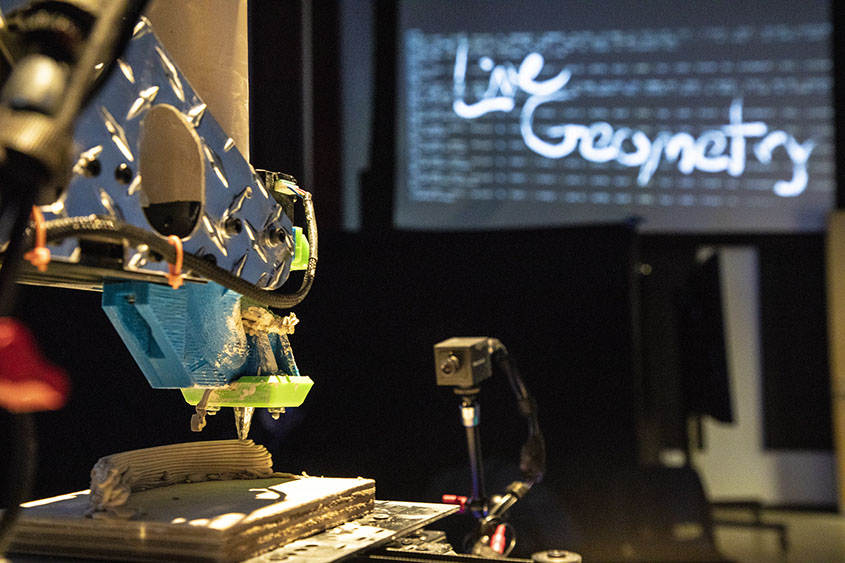
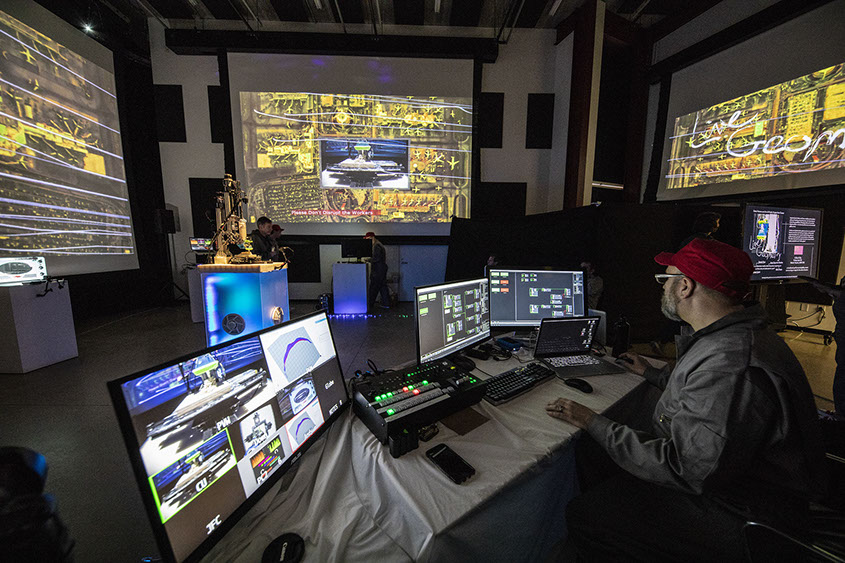

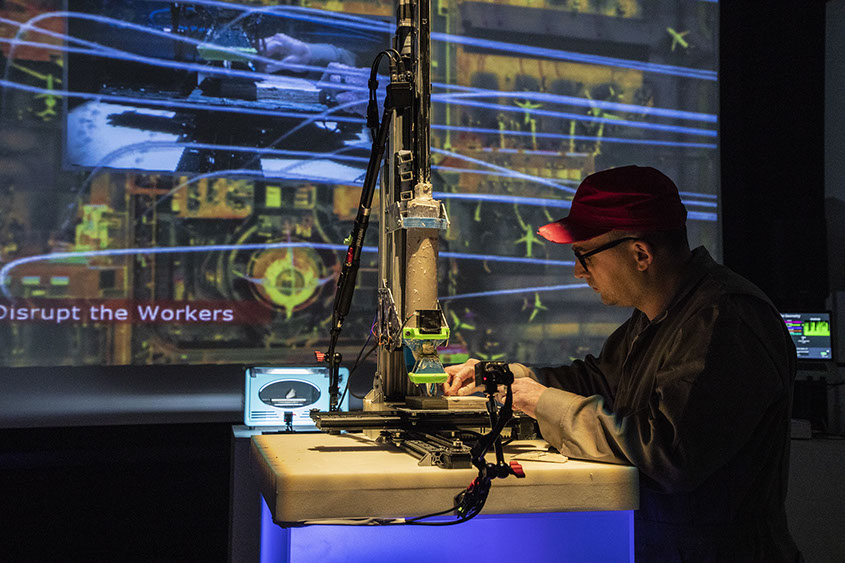
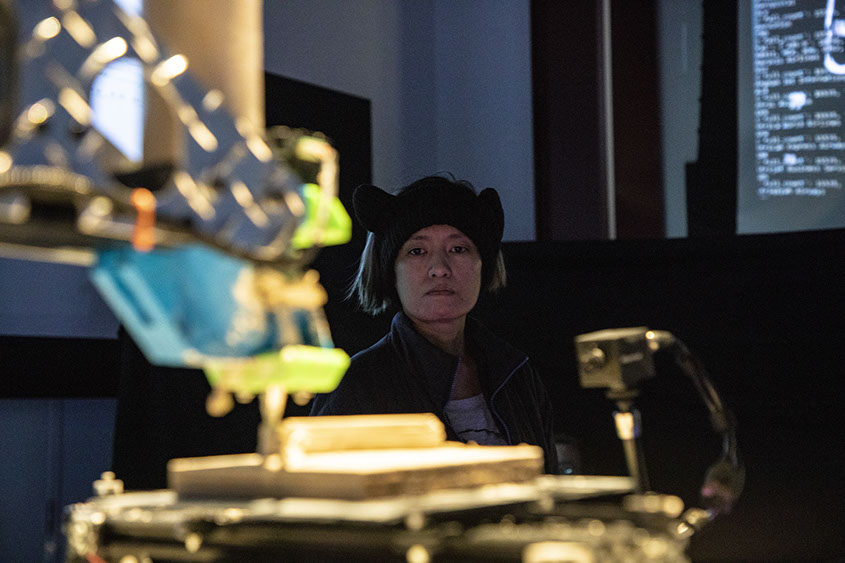
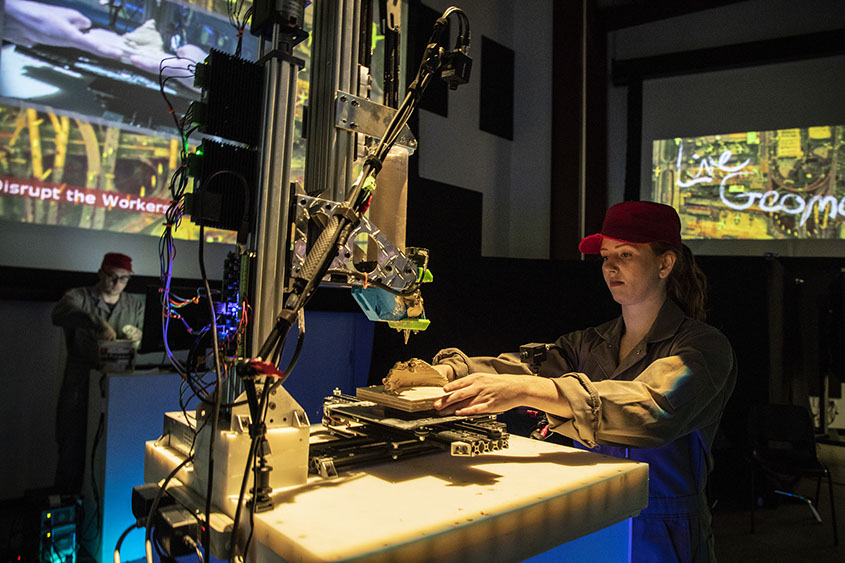
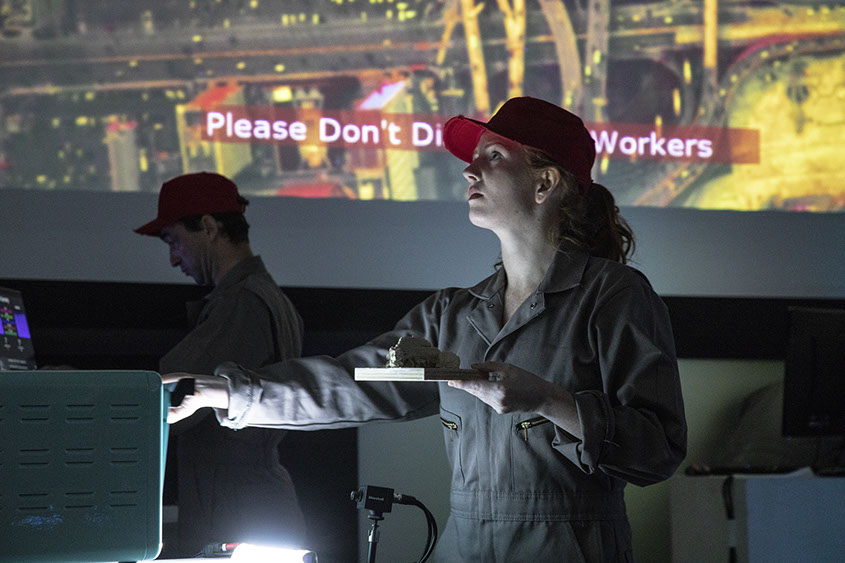

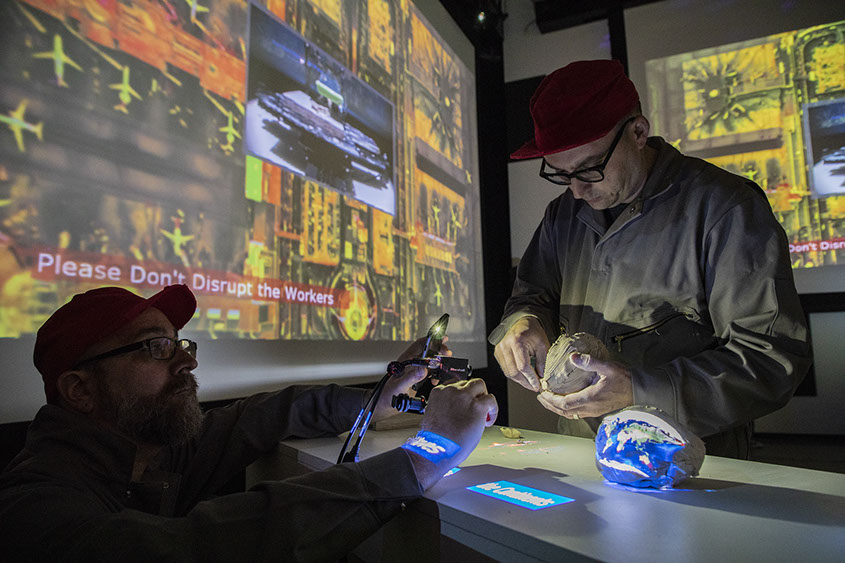

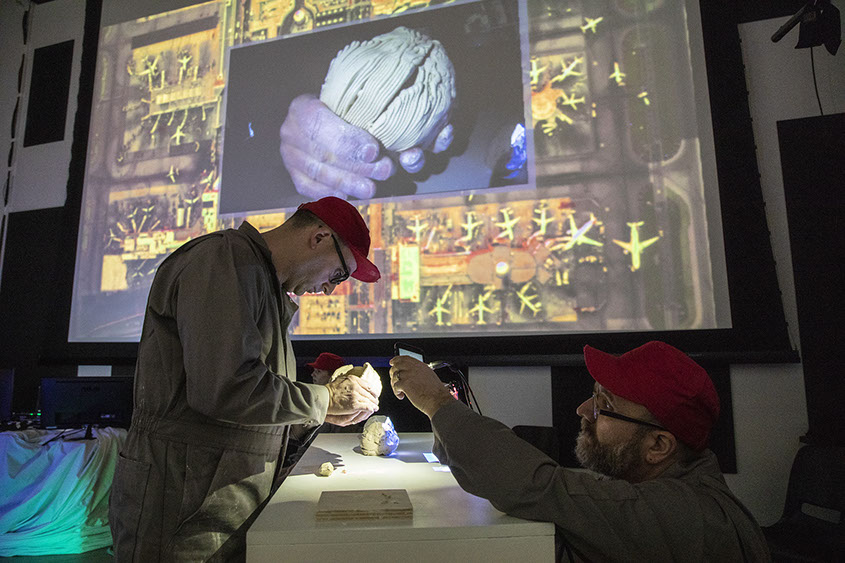
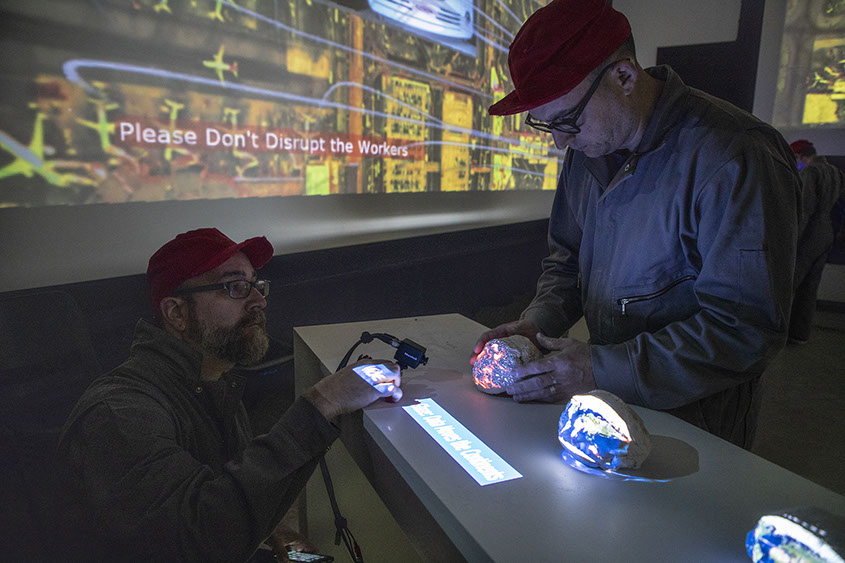
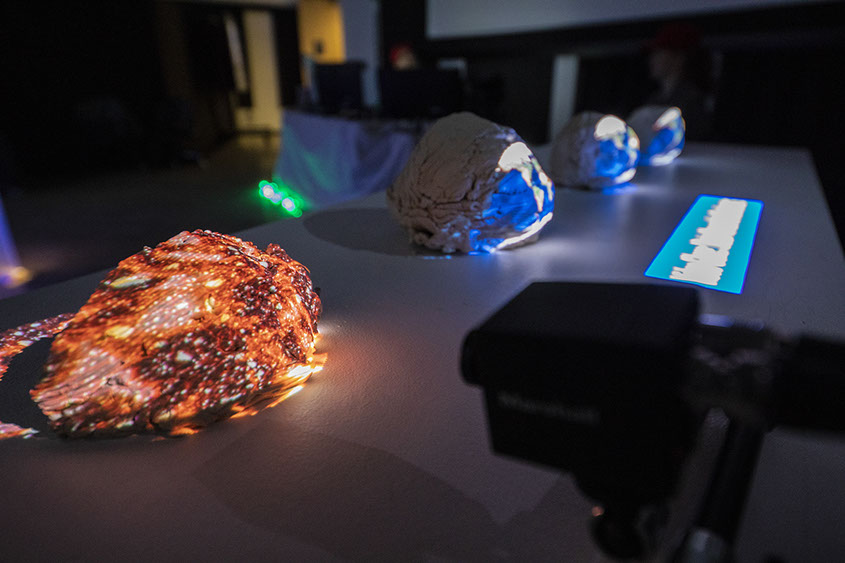
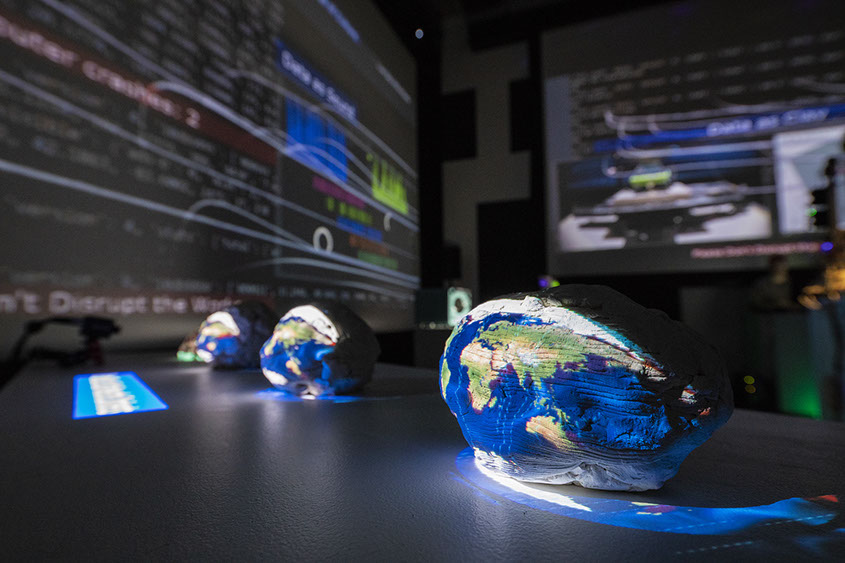
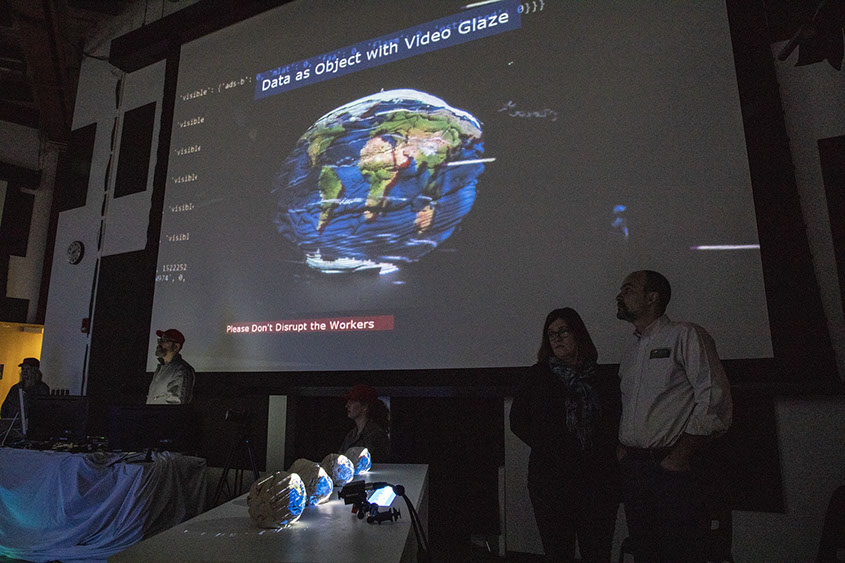

Detail of 3D clay printer, printing a slice of the earth based on the airline data.
Wide of the installation space from the point of view of video/camera control.
Printer attendant loads more clay.
Printer attendant cleaning the nozzle.
Audience member.
Attendant moving a finished slice (each slice takes eight minutes to print) of earth from printer station.
Attendant puts slice into kiln.
Toaster oven acts as kiln.
Camera attendant documents clay attendant putting together slices to form earth after they are fired in the toaster kiln.
Detail of slices being put together for display and Image Magnification.
IMAG in background of slices being displayed as final earth object.
Video glaze of molten lava mapped onto forming earth.
Detail of molten lava video glaze.
Finished art objects with video glaze animated in real-time by airline data.
Audience members with IMAG of finished art object in background
Traces of airplanes in the video glaze on the leftmost earth art object.
15 - 16
<
>
Video:
Link to: Video of presentation at LDI. (Note: I discuss multiple projects on this solo panel talk.)
Key Creative Team:
Co-Creator & Ceramics | Andy Casto
Co-Creator & Composer | Jean-Francios Charles
Co-Creator & Engineer | Steven Baek
Lighting Designer | Ted Brown
Production Manager | Aubrey J. Near
Performer | Angelia Mahaney
Program Note:
What happens when a video/new media artist, a composer, an engineer, and a ceramicist collaborate for a year? They write things like, “a fundamental change that emerging and digital technologies bring to our global society is the way in which art is created, experienced, exhibited, remixed and shared.” They ask questions like, “how can we create a durational performance about global migration and the sharing of culture that uses objects as performers and experiments with the traditional notions of performance and gallery exhibition, without specifically making a performance about migration and culture sharing in a gallery?
Inspired by the Dada and Fluxus traditions of transdisciplinary art making and performance, Live Geometry explores the possibilities of bringing data and inanimate objects to life in a durational performance and extended gallery event. A data set of global airline patterns into Iowa serves as a symbol of human movement and sharing of culture, while providing the foundation for a custom-built 3D clay printer to perform/create geometric representations of the globe. The data is also used to create immersive musical soundscapes, projections and “video glaze.
Process/Creative:
This was one of the first collaborations of some members of the Public Digital Arts (PDA) Cluster faculty. Associate Professor of Ceramics Andrew Casto (then Assistant Professor) and myself were talking about possible collaborations and connections between the PDA disciplines of ceramics, sculpture, theatre, dance, music, cinema, engineering, and computer science. It was clear how these different disciplines might collaborate and connect except for ceramics. Andy was very interested in digital techniques his discipline was beginning to embrace and how that might translate to meaningful collaborations. He told me about 3D clay printers people were using to create ceramics. This instantly felt like the way into a collaboration. Immediately the ideas began to flow. Drawing inspiration from objects as performers, I suggested that the 3D printer could be our central performer that an entire performance could be built around.
We explored ideas about process art and Dada and what it meant to create and exhibit artwork/performance in galleries and how we might disrupt traditional ways of creating ceramics behind closed doors and then presenting finished art on pedestals. The 3D clay printer could produce one piece at a time that then could be assembled to create an art object. All in real-time, in full view of an audience. This was really exciting and of course very performative and theatrical.
We invited fellow PDA cluster faculty, Assistant Professor of Music Jean-Francois Charles and former Assistant Professor of Engineering Steven Baek to have a meeting about ways audiences might experience ancient disciplines in new and interconnected modalities. We discussed how artistic and engineering disciplines intersect, as well as how we as a global community are connected to one another. In this first meeting we discussed how humans have always been on the move, slowly migrating across the globe, and along the way making objects with the clay of the earth, telling each other stories around a fire, etching drawings onto cave walls, creating music to express our emotions, dancing together as ritual and designing systems through the optimal use of available resources. Right there all of our disciplines are interwoven: ceramics, music, dance, theatre and engineering. We were onto something.
I wrote a grant for the Arts & Humanities Initiative (AHI) Program sponsored by The Office of the Vice President for Research (OVPR) of the University of Iowa. We applied and received $7,500 in funding.
Approach:
The transdisciplinary approach was based on a data set of human global airline patterns that served as a symbol of human movement and sharing of culture. This data was used to create a durational, real-time performance consisting of musical soundscapes, immersive digital video, and geometric shapes made via 3D clay printers. Traditionally, how data is interpreted in order to create structural, geometric shapes is an engineering problem. How that data is then translated to a 3D clay printer to create a piece of artwork is a ceramics and mechanical systems problem. How that data is then retranslated via visualization and sonification becomes design and music problems. When audiences watch a 3D clay printer perform and how humans move in space to create an art object becomes a choreographic problem. How the entire process is seen and exhibited becomes a theatrical event in a gallery setting.
Professor Baek created custom code to scrape flight information of airplanes entering Iowa. Professor Castro built a custom 3D clay printer that could be fed flight data and then translated to drive the XYZ coordinates of the 3D clay printer to create a 3D clay object. Professor Charles used the data to create a custom sound synthesizer with different data points driving different sonic elements. I used the data set to drive custom animations that were projected as “video glaze” onto the completed ceramic object.
We were invited to perform at the first University of Iowa Dada Futures Festival, which brought to campus an international symposium of scholars and artists. Our looping durational performance was scheduled on April 20th (4/20) for 4 hours and 20 minutes beginning at 4:20 pm. The Media Theatre (ABW250) was used for the first time as a performance venue.
There were five stations surrounding the 3D Clay printer which was on a lit pedestal in the center of the room:
- Real-time video mixing and projection mapping station
- Audio/music mixing station where audiences could control the custom built synthesizer
- 3D clay printer control station
- Toaster oven “kiln” station
- Ceramic artifact pedestal and viewing station
There were projections on the four walls of the room, creating an immersive environment. The Audiences were invited to walk freely around the performance space and could stay as long as they like. The room had two states which alternated every eight minutes (the time it took the 3D clay printer to print an object and the same time it took the toaster over kiln to dry the object). I designed the two states, live-operated between them, serving as VJ selecting different camera views and also served as live camera operator. The two states were:
-
3D printer creating a slice of an artifact.
- In this state the surrounding projections showed altered drone footage of LA International Airport, a live video feed coming from the 3D clay printer control computer, a live video feed coming from the synthesizer, and live video of closeups of the 3D clay printer and inside the toaster oven.
-
Moving the clay slice from printer to toaster kiln and toaster kiln to display pedestal
- In this state there was a closeup from a hand-held camera that I operated of Andy putting together the individual clay slices together to form a globe. Once placed on the pedestal the clay artifact had what we called “video glaze” projection mapped onto it. There was one look for the forming of the globe (pre-recorded video using data points in After Effects) and one look once the globe or earth was completed (real-time video of custom images moving using the data set).
I choreographed the movement of the four people in the space. Each person used a different looping route on a set-schedule to simulate a flight pattern around the room:
- VJ/Camera Operator Route: from VJ station to Pedestal/Display station
- Clay Operator: from Clay computer station to 3D printer to Pedestal/Display station
- Musician/Audio Operator: from audio/mixing station around space and back
- Clay Slice Mover: From holding area to 3D printer to toaster to pedestal and back to holding area
Teaching/Service:
Three students received grant funding to work on this project: an MFA stage manager, a senior BA designer, and a senior BA dancer.
copyright 2024
